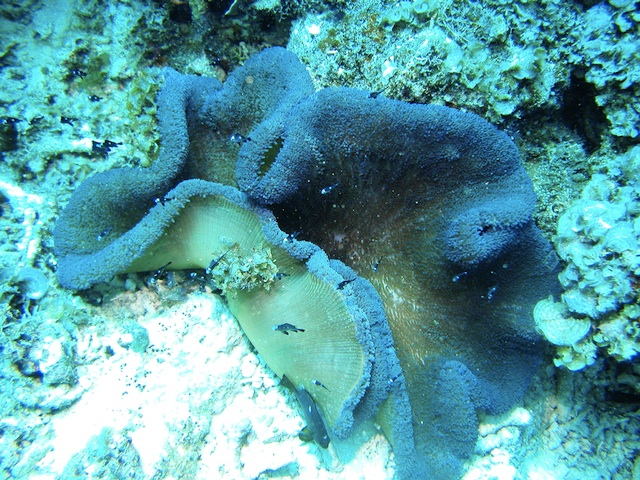 anemone blue carpet::Anemones attached to rocks or the sea floor.
anemone blue carpet::Anemones attached to rocks or the sea floor.Anemones in the aquarium though, will often move around until they find a place that they like and then stay put.
Most anemones survive in a symbiotic relation with with a marine algae called zooxanthellae.
The zooxanthellae are photosynthetic organisms whose waste products are used by the anemone for food.
Since the zooxanthellae require light to carry on photosynthesis, anemones in turn require bright light to thrive in the aquarium.
Anemones all need lots of light to do well.
Anemones prefer water free of organic wastes, which in most cases means you need to have an efficient protein skimmer.
Maintaining the levels of trace elements in the water by performing regular water changes or the addition of commercially available supplements also seems to be important.
Iron supplements also benefit the zooxanthellae in the anemones.
Moderate current, in addition to clean water, helps exchange needed elements and rid the anemone of waste products.
Some of the more delicate anemones seem to prefer higher temperatures in the range of 7880 f and ph in a consistent range of 8.
Feeding can range from 3 times a week to once every 2 weeks.
Some aquarists have had success not directly feeding their anemones at all, although we suspect their anemones are capturing food that is meant for the fish.
Lance fish, silversides, clams, scallops and other frozen marine organisms can also be used, but i find them more messy.
A large bag of peeled and deveined shrimp can be obtained from one of the local discount supermarkets and may last many, many months.
The jury is still out on vitamins.
Our suggestion would be to use them sparingly, or not at all.
Anemones vary in size from day to day, this is normal.
We make every effort to measure our anemones and give an accurate representation of size.
If your new anemone arrives and looks small, please be patient and allow a few weeks for it to adjust to your tank and lighting conditions.
Often times, the sting will not be readily aopparant, but in some people will result in an alergic rash, or pain.
If this occurs a good cure is to place the infected area under hot water, and pour vinegar over the area.
This neutralizes the chemical on your skin which is causing you pain or itching.
We guarantee that all aquariam species offered will arrive alive and in good condition.
No comments:
Post a Comment